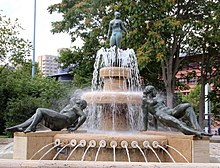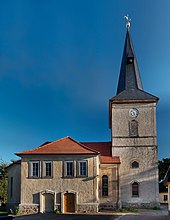Southern Neustadt (Halle)
|
Southern Neustadt district of Halle (Saale) |
|
|---|---|
| Coordinates | 51 ° 28 '24 " N , 11 ° 55' 47" E |
| surface | 2.389 km² |
| Residents | 15,230 (Dec. 31, 2019) |
| Population density | 6375 inhabitants / km² |
| Incorporation | May 3, 1990 |
| Post Code | 06124 |
| prefix | 0345 |
| state | Saxony-Anhalt |
| Transport links | |
| Federal road |
|

The Southern New Town is a neighborhood of the city district Neustadt, City West District of Halle (Saale) . As of December 31, 2019, it had 15,230 inhabitants.
location
The Südliche Neustadt borders in the north on the Nördliche Neustadt (Halle) , in the east on the district Saaleaue and in the west on the industrial area Neustadt (Halle) , as well as the Westliche Neustadt (Halle) . The border of the district runs in the southeast over a dike along the B80, in the north over the northern lane of the main road and in the west along the S-Bahn line (Zollrain).
Since the district is located in the former floodplain of the Saale, the Passendorfer Damm, which runs along Bundesstraße 80, was filled in as early as 1935.
A large part of the southern Neustadt is located in the area of the former village of Passendorf. Large parts of the village were demolished for the construction of the new town. Only a few houses not far from the Passendorf church and the Passendorf castle in the area of the school square and Kammstrasse and Teichstrasse have been preserved.
Infrastructure
In the northeast, directly on the B80 and the main road, is the Saale-Center, a shopping center on two floors and with an underground car park. There is a large Kaufland market on Zollrain.
The district has four primary schools, a community school, a grammar school, three special schools and ten children's facilities.
An excursion destination is the Südpark, which is surrounded by the church pond and the B80.
With the S-Bahn station “Zscherbener Straße”, the district has a connection to the S-Bahn in Central Germany .
history
Passendorf before incorporation into Halle (Saale)
Passendorf was first mentioned in a document in a deed of donation from Bishop Werner von Merseburg in 1091. Until 1815, the place belonged to the Lauchstädt district of Merseburg , which had been under Electoral Saxon sovereignty since 1561 and belonged to the secondary school principality of Saxony-Merseburg between 1656/57 and 1738 .
The village was the northernmost place of the Lauchstädt district. In the west the place bordered on the county of Mansfeld , in the north and east on the Saalkreis , which was under the sovereignty of the Archbishopric of Magdeburg . The Saale marked the natural border to the Saalkreis in the east.
After the nearby city of Halle and the Saalkreis came to the Duchy of Magdeburg under electoral Brandenburg and in 1701 under Prussian rule, Passendorf gained importance as a border town across from Halle. As a bar, Passendorf in Electoral Saxony was a popular destination for citizens and students from the Prussian hall. Forbidden and persecuted student associations met in the village for their meetings. After his expulsion from the University of Halle, the scholar Christian Wolff stayed for a short time in Passendorf. After theater was banned in Halle, Passendorf received a boom in 1772 as a theater village on the edge of Halle, on the other side of the Prussian border.
By the resolutions of the Vienna Congress Passendorf came in 1815 to Prussia and in 1816 the county Merseburg in the administrative district of Merseburg of the Province of Saxony assigned to which he belonged until the 1950s. Around 1900 Passendorf had 1,372 inhabitants and the Passendorf manor district had 38 people. Due to the rapidly growing population in the Halle area, there was already a need to develop new living space around 1900.
The first plans to develop the area west of the old town of Halle were made at the beginning of the 20th century and in the 1920s, as the old town of Halle offered little opportunity for expansion due to the narrowing between the Saale in the west and the railway tracks in the east. However, they were not yet implemented at the time, as the area lies in the natural flood plain of the Saale. Only with the construction of the Passendorfer and Gimritzer dams in the 1930s could the flooding of the built-up area on the western bank of the Saale be prevented.
Passendorf as a district of Halle (Saale)
During the district reform in the GDR, Passendorf was incorporated into the city of Halle (Saale) on July 1, 1950. Since then, the place has belonged to the Halle-West district.
In 1958, at a conference of the Central Committee of the SED on the subject of the GDR's chemical program, the subject of the development of the area west of Halle (Saale) was taken up again. The conference decided on the settlement of workers near the chemical sites of the Buna works in Schkopau and the Leunawerke in Leuna . For this purpose, 19 locations were examined between 1959 and 1963. The SED Politburo chose the area between the old town of Halle, Nietleben and Passendorf in 1963, as there was enough free arable land in the area and it was hoped that the southwest winds there would produce the least air pollution for the new residential area.
Construction of Halle-Neustadt began as early as December 13, 1963 with the underground development of the later residential complex I and the prefabricated building. The prefabricated building that manufactured the concrete parts for the planned residential units opened on February 1, 1964.
Passendorf as part of Halle-Neustadt
The foundation stone of Halle-Neustadt was laid on July 15, 1964. The new town was placed on the edge of the Saale floodplain between the town of Zscherben and the Halle districts of Passendorf and Nietleben, with Passendorf largely being demolished. The old town center of Passendorf was east of today's S-Bahn station “Zscherbener Straße” in the area of Kammstraße and Teichstraße. The “New Village” to the north, like the Unterdorf to the south and the Oberdorf to the west beyond the S-Bahn line, had to give way to the prefabricated buildings. With the construction of the Südpark residential area, the area around Kammstrasse and Teichstrasse became a kind of village oasis in the cityscape, which is otherwise characterized by high-rise buildings.
In the period that followed, apartments for 39,000 residents were built in Halle-Neustadt (as of 1970). On May 12, 1967, the new settlement of the Halle-West district was declared the city of Halle-Neustadt and the area was formally separated from the urban area of Halle. After a vote on the occasion of the local elections on May 6, 1990, Halle-Neustadt was united with the city of Halle. Since then, the former urban area has been the Neustadt district within the West district of the city of Halle with the four districts of Nördliche Neustadt , Südliche Neustadt, Westliche Neustadt and the Neustadt industrial area . The old location of Passendorf has since been part of the Südliche Neustadt district.
Witnesses of the old Passendorf in Halle-Neustadt
Remnants of the old pass village have been preserved along the Kammstrasse and Teichstrasse. These include the Passendorfer Gut and Passendorf Church:
- Place three lilies
At “Platz Drei Lilien” there was an inn of the same name, which was the first permanent theater in Halle and the surrounding area. In this area the theater, customs houses and restaurants have disappeared; only the toll bridge has been preserved to this day.
- Passendorfer Gut
The forerunner of the later manor of Passendorf is a farmyard set up on this site by the Teutonic Order, which is called "Mönchehof" around 1291.
At the beginning of the 16th century, a free knight's seat with high and low jurisdiction was built on this site. The commandery came into the possession of the Neuwerk monastery and, after its abolition, became the archbishop's property of Cardinal Albrecht of Brandenburg . In 1531 he left the estate to his childless chancellor Albrecht Christoph Cruschwitz, called Türck. After his death, the property changed hands several times. It was owned by the von Goldstein family for many decades; Finally, the last representative, Carl Gottlob von Goldstein , sold the manor to the Landjägermeister Rudolph von Boeltzig in 1761. In 1889, the Otto family were the last private owners to purchase the property.
After the first manor house, built around 1808, was demolished, a new building in eclectic style was built in 1898, the so-called Passendorfer Schlösschen , which is now a listed building .
With the construction of Halle-Neustadt, the former manor house became a domicile for cultural workers in various fields. Until the beginning of the 1990s there was a branch of the conservatory, working groups of the Kulturbund , beer garden, restaurant and also a night bar in the small castle, renamed the clubhouse " Johannes R. Becher " .
The Heimatbund Passendorf eV, founded in 1990, which had its domicile in the manor house, tried to save the manor house from decay during the vacancy years since 1993.
After being offered for sale several times since the 1990s, the property finally goes into private ownership in 2008. Renovation and construction work has been ongoing since then. In addition to apartments in the manor house, other residential complexes, including for age-appropriate living, have already been built on the site of the Passendorfer Gut.
- Passendorf Church
The Passendorf church on Schulplatz was built around 1723 and is currently used by the Protestant parish of Halle-Neustadt. The church administration had its baroque furnishings removed in the 1960s.
- Kastanienallee
The remains of the dilapidated estate can still be seen in Kastanienallee.
- Halle-Passendorf volunteer fire department
The Halle-Passendorf volunteer fire department is one of twelve volunteer fire departments in Halle. It has existed for 140 years in 2015.
Web links
- https://halle.de/ - The Südliche Neustadt district on the website of the city of Halle.
- Passendorf in Halle - The village in the city on hallelife.de.Retrieved on January 23, 2019
- Passendorf district: The old smuggler village of Halle Mitteldeutsche Zeitung from May 31, 2017. Accessed on January 23, 2019
Individual evidence
- ^ City of Halle: Overview of the city district
- ^ City of Halle (Saale), Department of Residential Affairs: Halle in Figures 2019 . Published online at https://halle.de ( pdf , 173 KB) in 2020.
- ↑ South Park Halle (Saale)
- ^ Karlheinz Blaschke , Uwe Ulrich Jäschke : Kursächsischer Ämteratlas , Leipzig 2009, ISBN 978-3-937386-14-0 , p. 84 f.
- ^ The district of Merseburg in the municipal directory 1900
- ↑ City in the River. Saalepfad.de, accessed on July 15, 2018 .
- ^ Passendorf on gov.genealogy.net
- ^ Article about Passendorf in the Mitteldeutsche Zeitung of April 27, 2014
- ↑ Hallespektrum.de: Adjust Dorfer castle is residential
- ^ Website of the Halle-Passendorf volunteer fire brigade







